REMEMBERING KARUPPIAH
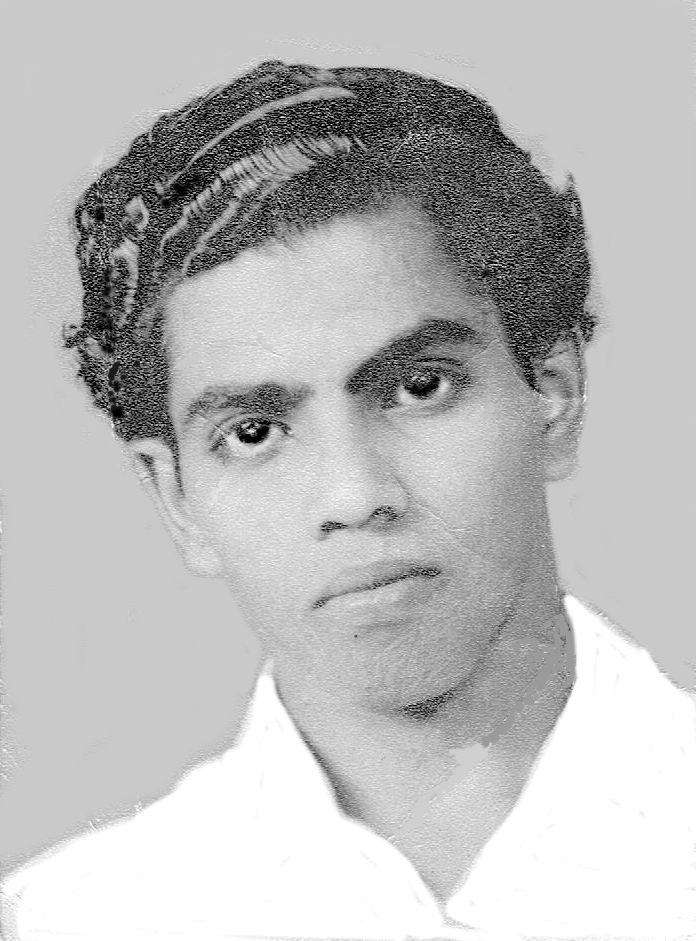
REMEMBERING KARUPPIAH
28 April 1931 to 24 May 1992
This is a story of Mr. P. Karuppiah, a Tamil school teacher who became a Bahá’í in 1961 and served the Faith with great devotion and fortitude. The history of the Faith in the town of Muar can never be written without ample mention about this firm, faithfuland loyal servant of Bahá’u’lláh.
It was on 11 March 1961 that Karuppiah accepted the Faith through the teaching efforts of the friends from Malacca. His enthusiasm led him to organize several more firesides with Malacca providing the speakers. In accepting the Faith, Karuppiah was clear in his mind about the path that he had chosen for himself, and he was determined to live life to the best of his ability. He immediately started to put to practice whatever little he had understood on the Faith.
It was astonishing that Karuppiah gained a deep understanding of the Faith quite fast. At the firesides, he listened attentively to the Bahá’í speakers and entered into lengthy discussions with the visiting Bahá’ís. He became an avid reader and was reading whatever literature was made available to him. Although he was a Tamil school teacher, he had a fairly good knowledge of the English language as well. The example set by the string of visitors to Muar town, especially from Malacca, such as Leong Tat Chee, Raymond Peter, S. Vasudevan, Surinder Singh, and Bhaskaran moved him. He saw that they practiced what they preached, and that too touched him deeply. A Local Spiritual Assembly was elected during Ridván 1961. William Koren, Headmaster of Maharani School was elected Chairman, Karuppiah as its Secretary and Inyce Koren as Treasurer. Local Spiritual Assembly meetings were held at the home of William Koren at Lorong Sekolah. Karuppiah felt very comfortable moving with Miss Inyce Koren and her brother William Koren hailing from the middle class. In the very first year of the acceptance of the Faith, Karuppiah participated in almost all meetings in Muar.
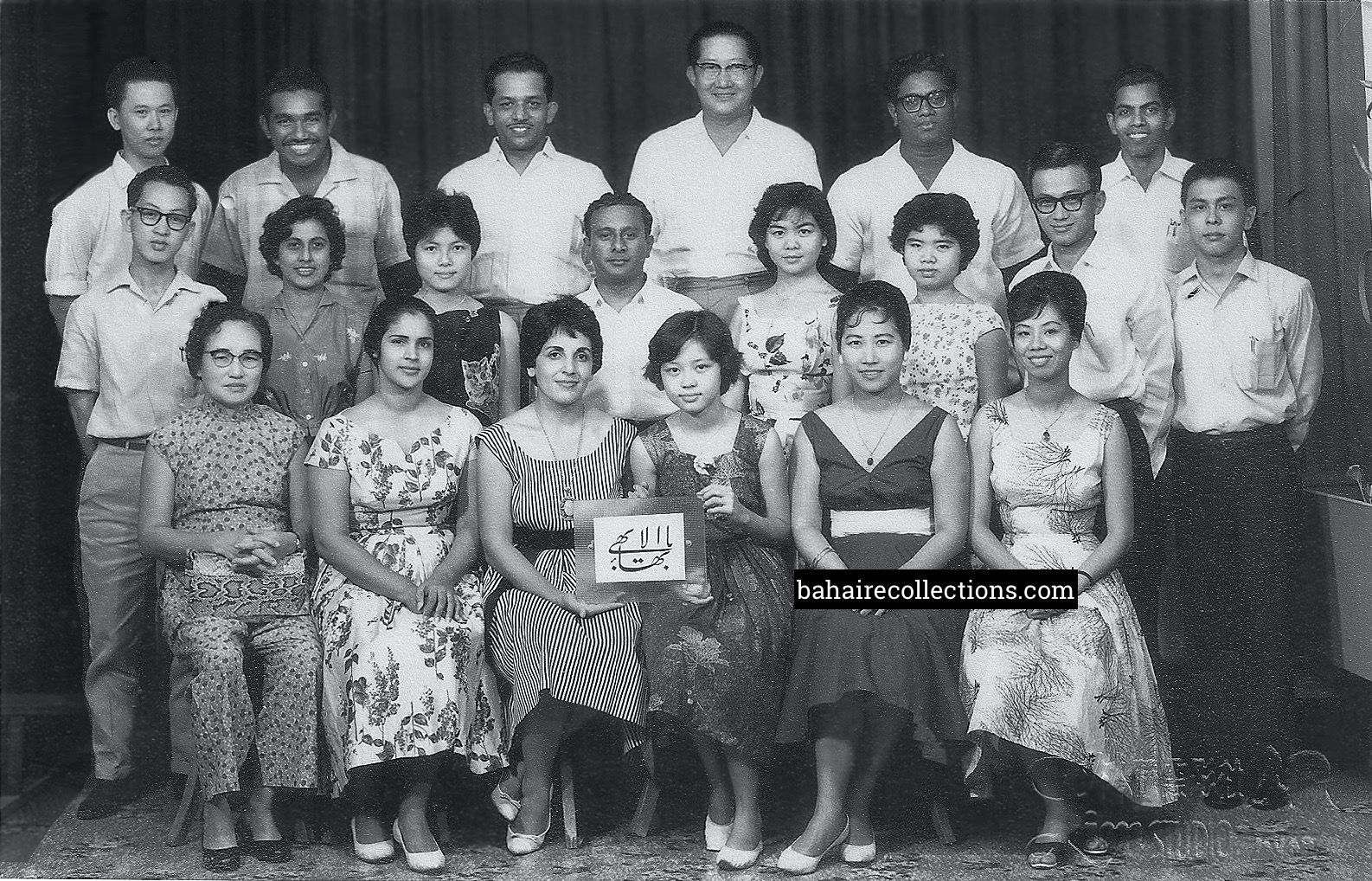
Some believers of Malacca and Muar with Mrs. Shafiqi Fatheazam, 1961. Seated (L-R) Mrs. Leong Tat Chee, Mrs. Betty Fernandez, Mrs. Shafiqi Fatheazam, (unknown), Mrs. Lily Chinniah, Koh Ai Leen. Second from the left in the middle row is Miss Inyce, and at the center of the same row is William Koren. Back row – Raymond Peter is second from left, E.A. Fernandez third from left, Leong Tat Chee fourth from left. Standing at the extreme right at back row is Karuppiah
Now comes informing his wife of his acceptance of the Faith in 1962. Karuppiah at first never informed his wife Ponnayee that he had become a Bahá’í. It so happened that one-day Karuppiah bought home some meat and requested his wife to cook for dinner in March 1962. When he told her that he was fasting, his wife wondered what he was talking about. To her, fasting according to her Hindu belief was to consume only vegetarian food. When she asked for further clarification, Karuppiah did not disclose much but told her just to cook and added that he would be fasting for 19 days. That evening she noticed Karuppiah was holding a prayer book and saying prayers with a glass of water with Tulsi leaf (basil leaf) inside. The Tulsi leaf was used as an herbal treatment in the Indian community. After prayers, Karuppiah broke the fast with this water and ate dinner his wife had prepared. That was his first fasting after he had accepted the Faith.
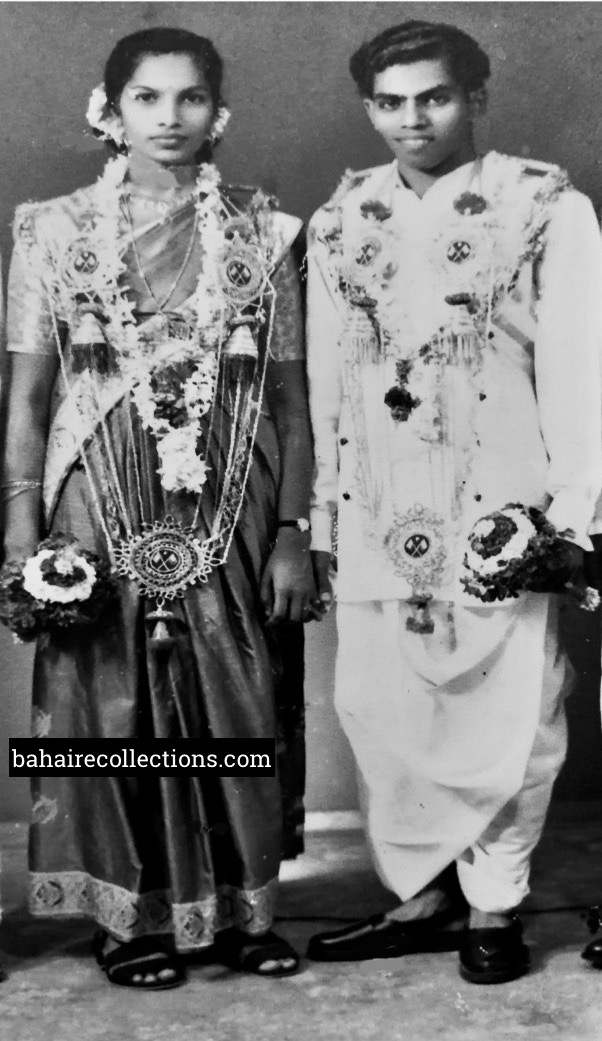
Marriage on 17 March 1956
Mrs. Ponnayee started to see some dramatic changes in her husband and was curious to learn of the source of these changes. One day when Karuppiah explained to her about the Bahá’í Faith that he had accepted, she expressed happiness, as by then she had seen many changes in him. When Karuppiah asked her if she would accept the Faith, she hesitated saying she was not literate in English. When Karuppiah explained that acceptance of the Faith was not conditional upon knowledge of any language, she signed the Bahá’í declaration card. Karuppiah was happy that with his wife accepting the Faith as he could now build a Bahá’í family with her support. Mrs. Ponnayee joined him in establishing a good Bahá’í family. She too served in the Local Spiritual Assembly for a few years.
A COMMUNITY LEADER IN THE MAKING
Then came the expected-opposition, crisis and final victory. It was a big decision for him to have accepted the Faith at a time when he was deeply involved and holding high positions in several social organizations and was held in high esteem for his commitment toward the Indian community. But Karuppiah’s acceptance of the Faith was not without criticism or condemnation. As soon as Karuppiah accepted the Faith he drew criticism from several groups in which he was associated. Muar town with a large base of Indians with several organizations saw in Karuppiah a great potential and resourcefulness. The leaders of those organizations too kept persuading him, at times in irate tone, to return to their fold and join them in their pursuits. One and all they rose against Karuppiah – such as the politicians, his colleagues in the school, community organizations, temple committee, and the Tamil Youth Bell Club, to name but a few. They were concerned about having lost out a very promising and resourceful person. They had every reason to win him back.
Karuppiah was a leader in the making in the Muar Indian community when the Faith wafted over him and changed his destiny forever. Having migrated into Malaya from Tamil Nadu in 1935 at the age of four, he studied in an English School in Johor Bahru, and later came back to Muar and attended the Adult Education in Sanmarka Sangam Tamil School. Having successfully passed his Standard Six Tamil School Government Examinations in 1946 at the age of 15, he was first assigned as a teacher at Kempos Estate, near the town of Tangkak in the state of Johor, where he served for 3 years. He then went for a teacher training course in the town of Segamat. Upon completing the training he was posted to the Nandanar Tamil School at Jalan Road (Daud Road) in the town of Muar. When the National Type Tamil School was introduced, Karuppiah was posted to the Sanmarka Sangam Tamil School at Khalidi Road in the same town of Muar, which later came to be called the National Type Tamil Primary School.
As a student, he was very keen on studies and took a great interest in sports. Even during his schooldays, Karuppiah had developed a friendship with Mr. Shanmugam Chettiar who was on the Board of Directors of the Tamil School in Muar and the late Tan Sri Dato G. Pasamanickam who was one of the high ranking figures in the Malaysian Indian Congress (MIC), a political party.
Karuppiah loved and acted in stage dramas that were staged in Muar town to raise funds to save the properties of the Indian community at Jalan Daud. As a social worker, Karuppiah was Chairman of the Muar Tamil Youth Club for many years. The Tamil Youth Clubs were spread out throughout the country to get the youths to be involved in social services. He organized a set of volunteers from the Tamil Youth Club of Muar to involve in social and welfare services in his hometown. He introduced a white uniform for the volunteer team. For many years the Muar Indian Community benefitted much from the services of these volunteers at many family functions and temple festivals. Karuppiah also valued the importance of education and gave free tuition classes in the Tamil language. He even went out of his way to assist students who had gained entrance into local universities to secure state government scholarships by approaching those in authority. He also helped to establish a branch of the National Land and Finance Co-Operative Society in Muar town. He believed in uplifting those downtrodden in society through the political platform. He worked very closely with the late Tan Sri Dato G. Pasamanickam, leader of the Malaysian Indian Congress in promoting the growth and development of the party. He was an excellent speechwriter for the leading politicians. Karuppiah was said to be instrumental in the making of many political and community leaders. He had served for many years as the secretary of the Management Committee of the Sri Muthu Mariamman Temple in Muar. He also assisted in the acquisition of the Hindu burial ground at Jalan Ismail in Muar.
Very few Indians in Malaysia had had such a wide range of experience and exposure in various aspects of social life, together with commanding high respect. In view of his background, Karuppiah was a natural choice as a community leader, who was expected to lead in the upliftment of the Indian community, predominantly through the political platform. But the Divine will had intervened to use him for His Cause.
The first blow came from the political circle. The politicians had high expectations from him. Karuppiah was expected to enter into politics where he would surely excel as a master orator with a good command of the Tamil language. But here was Karuppiah who was very much attracted to the Faith by the wonderful teachings of Bahá’u’lláh on love and unity which was amply and sincerely practiced by the Bahá’í community. It was this kind of genuine unity that he was looking for. It dawned upon him that he could not find such kind of unity in the divisive political organizations in which he was a member for several decades. He put his heart and soul for the greater and true unity of the entire mankind rather than unity his own kind. He made a firm decision to leave politics for good. This was a total disappointment to the political leaders who wanted to make use of his Tamil oratory skills. He knew that as one of the early members of the political party some kind of material rewards would come by one day had he continued to stay on. But Karuppiah was decided to give up material benefits for eternal happiness as promised by His Creator. The politicians kept visiting him in his house for months to persuade him to return to politics. Karuppiah respectfully and politely showed them the vision that Bahá’u’lláh has for the entire mankind, and that he had changed his heart from loving his kind alone to love the entire mankind. He turned all conversations into firesides and taught them the Faith. Unable to argue any further they too left him to himself. They found Karuppiah firm as a rock and left disappointed. Yet deep inside they respected him for that very firmness that he had chosen.
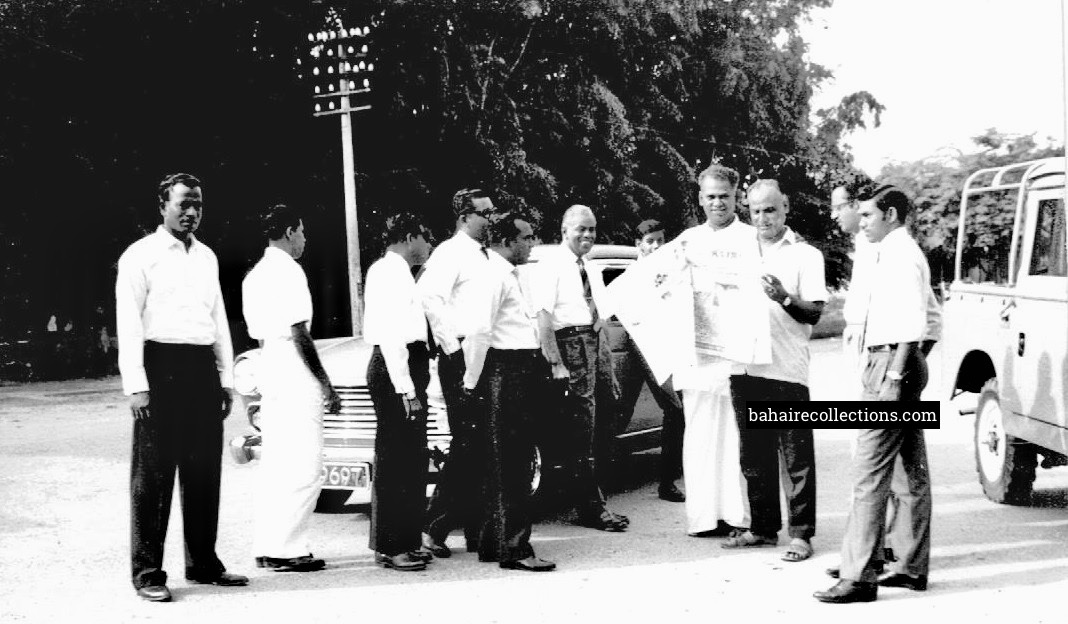
Karuppiah, second from left visited by political leaders. Tan Sri Pasamanickam is in the middle with a neck-tie. N.T.S. Arumugam Pillai is fourth from right.
The most vehement attacks were leveled against him by his colleagues in his school, whom he had to face daily. There was a widely held view in the Indian community where teachers who were held in high esteem were to play the role of custodians. It was their understanding that to change one’s religion was treachery to the community, little realizing that freedom of belief was a basic human right. They first talked to Karuppiah subtly, and when they saw him unwavering, they started to condemn him directly. When they had expected Karuppiah to retort, he smiled at them, and it was this smile and silence on his part that became the biggest weapon in silencing his critics. Mention has to be made that there had been several Tamil school teachers who had accepted the Faith, not only in Muar but throughout the country. But many left the Faith for not being able to withstand the onslaught from the community. Here was Karuppiah who was immovable as a mountain.
In the midst of all these mounting attacks, mostly mental, Karuppiah emerged victorious. Time proved that tough times do not last, but tough people do. Karuppiah was a soft-spoken person, but an unshakable rock in his belief. It was this very firmness in his faith that ultimately won the praises from the same circles that had opposed him. Karuppiah loved the Faith and made a decision which he applied for himself and urged the members of his family to follow. He pulled up all his might to live the Bahá’í life to the best of his ability as he knew he was under the spotlight of the community. He knew that one slightest deviation from the lines of the Faith would bring shame to the Faith and its Founder. Karuppiah expected all his family members to follow suit. That was his most earnest request to his family members. And certainly, it was a lifelong and painful commitment.
With his prime involvement, the Muar community organized a grand Naw-Rúz party in 1962 with the help of the Malacca friends, which attracted a huge crowd, ending up in much publicity for the Cause. That was also a new beginning for him and his family. Each year the family celebrated Naw-Rúz and invited friends, a practice that goes on to this day. Karuppiah himself was a good cook and provided the best hospitality. At times Karuppiah had prepared eight kinds of dishes for just a single guest. When the guest enquired on why the dinner had to be so lavish, Karuppiah explained that he believed in the best hospitality.
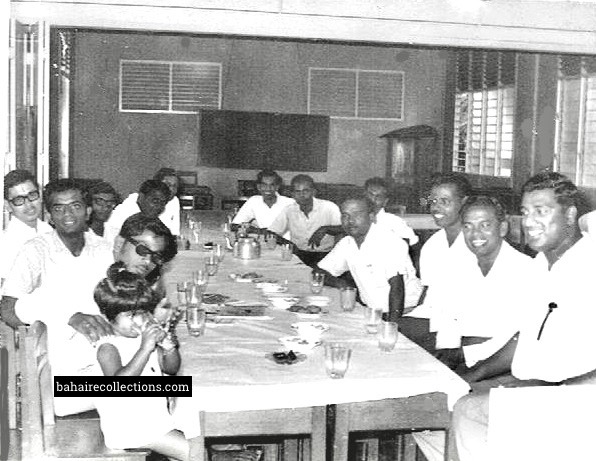
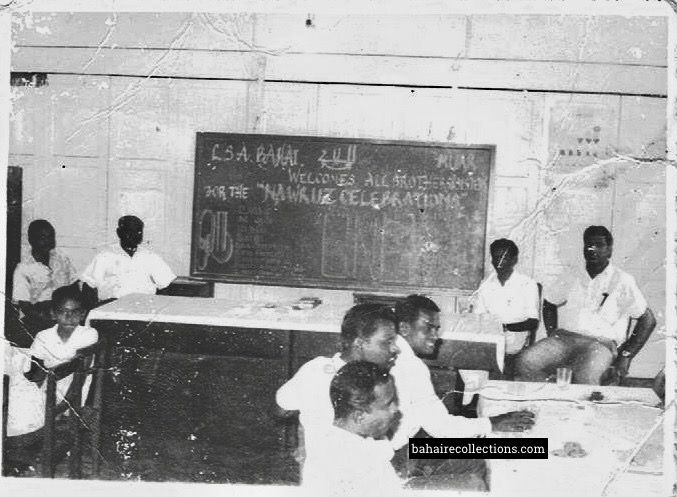
Naw-Rúz Party held in the school, 1962.
Things started to change in the middle of 1965 when Karuppiah had to hold the fort all alone. Karuppiah, Inyce, and William Koren were the backbone of the community in the early days. William Koren started to concentrate on social work from 1965, while Inyce got married and had to concentrate as a homemaker, with her husband Dr. Gopinath coming from a strong Hindu background. Likewise, many who had accepted the Faith thinking that it was some form of social organization, started to leave when they discovered that it was a religion that demanded high standards. Karuppiah started a lonely battle, emerging as the key figure in the Muar Bahá’í community. There were times he had to shoulder the responsibility of the entire community but he with his family maintained the flame of the Faith. He soldiered on relentlessly to ensure the Local Spiritual Assembly which was called the “Mother Assembly of Johor State” was re-elected year after year. And the consolidation of the friends and the community became a grave concern for him. On his own accord, he organized deepening classes for the believers and invited outstation believers to come to Muar to be speakers. Mr. Appu Raman from Kuala Lumpur had made several visits to deepen them.
One other major factor for this poor turn of affairs was the lack of reading material in the Tamil language. In order to alleviate this situation, Karuppiah took upon himself the task of translating into the Tamil language some of the Writings of Bahá’u’lláh. This document he prepared and called “Some Laws and Ordinances of Bahá’u’lláh” produced on cyclostyled papers became a great and invaluable asset among the Tamil speaking believers not only in Muar but across the country. That was one of the pioneer efforts in educating the Tamil speaking believers in Malaysia on the laws of Bahá’u’lláh and was well appreciated and admired by individuals and institutions. As Secretary of the Local Spiritual Assembly, he used to prepare newsletters, which was not common in Tamil speaking communities in those days. He would also conduct a deepening class in the Tamil language for the new believers.
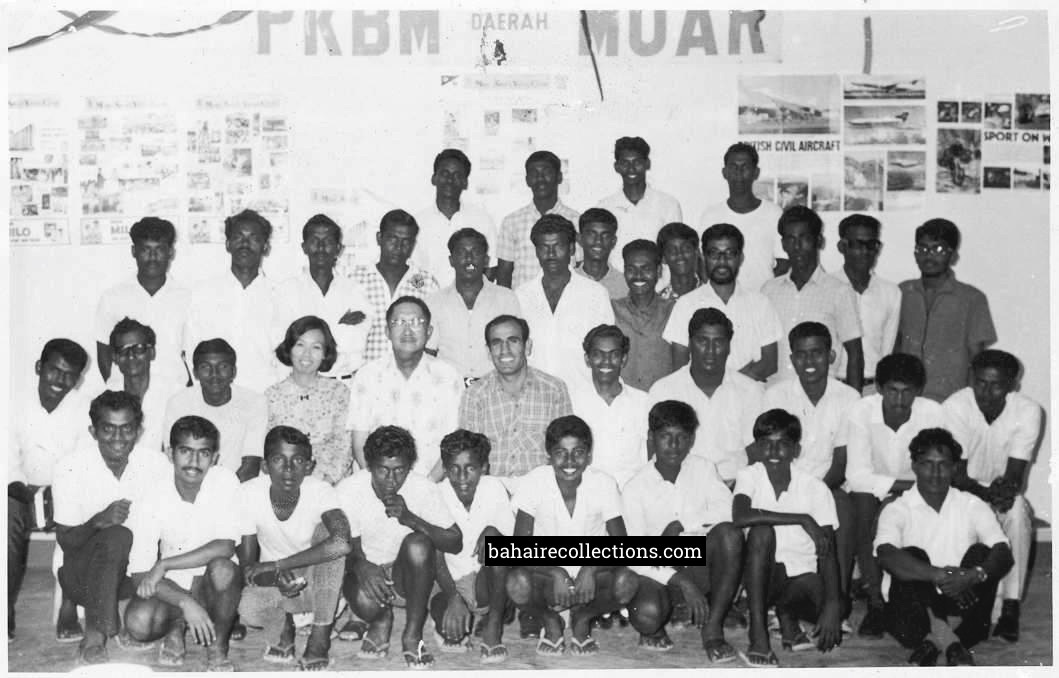
Visit in 1970 by Koh Ai Leen (seated fourth from left), Leong Tat Chee (fifth from left) and Nasser Jaffari from Thailand (sixth from left). Next to Nasser is Karuppiah.
When he had accepted the Faith, he was an ordinary Tamil school teacher. He organized small Bahá’í gatherings at his small wooden house at 27A, Jalan Khalidi in Muar. Whenever there was a need to organize large scale gatherings such as Naw-Rúz party, Teaching Conferences of meetings of Local Spiritual Assembly, Karuppiah used the Nandanar Tamil school hall at Jalan Daud as well as the hall of the Sekolah Rendah Jenis Kebangsaan Tamil at Jalan Khalidi. Later in the early 1970s as the community grew in numbers the Local Spiritual Assembly rented a house at 102, Jalan Khalidi, which became the first Bahá’í Centre of Muar town. His own house was always full of Bahá’í s, talking and laughing away whenever there was a gathering. He ensured his children attended all Bahá’í activities and took part in the physical arrangements for those activities. Whenever Feasts were held in his house he himself would cook as he was a good cook. People loved his mutton curry. And there was always ample food for all. He was generous in his hospitality. As he was well disciplined, he expected the same standard from his family members.
Although Karuppiah had left all his positions in the outside world, he was still sought for some favors, which Karuppiah obliged. One of the important events in the history of the Indians in Malaysia was the coming of Mr. C. N. Annadurai, (Chief Minister of Tamil Nadu, India from 1967 to 1969) for the First International Tamil Research Seminar in Kuala Lumpur in 1966. Taking advantage of his presence in Malaysia the community in Muar organized a gathering in his honor at the Cathay Cinema Hall. And, it was Karuppiah who was given the honor of delivering a welcome speech at that event.
Meanwhile, Bahá’ís from the outstation visited him and his family, throughout his life. Yankee Leong himself found happiness to pass a few nights in Karuppiah’s house from time to time. Later visitors from abroad such as Indonesia, Papua New Guinea, and Sarawak came and stayed in his house. There is no visitor who had come to his house and left without partaking in the tea or a meal. His hospitality was about the best, and the visitors not only felt very comfortable but also had no heart to leave.

Yankee Leong, the first believer of Peninsula Malaya having a meal as a guest of Karuppiah.

Visitor from Papua New Guinea, 1986
With a burning passion to share the message of Bahá’u’lláh, Karuppiah himself was often missing from home. Almost every day he would go out teaching after school and return home late midnight. He was able to spread the Faith in the wider community through the prior contacts he had developed. They had high regard for his loving nature, kindness, and generosity that they came to also respect the Faith he belonged to. He used to borrow a motorcycle from another teacher and a Bahá’í, Mr. Kanniah to go for teaching from one estate to another in areas surrounding the towns of Pagoh, Panchor, Air Manis, Parit Jawa, Tangkak and even as far as Jementah. Later he bought on his own a motorcycle mainly for the purpose of teaching the Cause. Karuppiah also travelled on his motorcycle to Tangkak estate in the state of Johor, Merlimau in the state of Malacca to conduct regular deepening classes.
An incident that Karuppiah used to relate to his family members as a miracle was a teaching trip that he undertook to Jementah on his motorcycle. On his return journey, it was raining heavily and his motorcycle broke down right in the middle of the jungle on an isolated road. It was pitch dark at midnight, and there were no street lights either. He tried to start the motorcycle several times and it would not start. As a lonely person in a real desperate situation, Karuppiah resorted to ardent prayers. After spending some time in prayers, he tried starting the motorcycle, and with just one kick it started. He rode the motorcycle to his home. As he entered the compound the engine stopped. As he checked the gas tank, he saw it completely empty. He froze for a moment. He entered his house and said a prayer of praise and gratitude and spent some time meditating on the unfailing help of God during moments of heedlessness. The following day he called for a meeting of all his family members and explained the incident and urged them to have full faith that Bahá’u’lláh is with us every moment of our lives and never for a moment He leaves us.

Visit by outstation believers, circa 1985. Standing L-R: S. Ravichandran (Petaling Jaya) M. Munusamy (Seremban). Satanam of Seremban is 6th from left. Seated at the extreme left is Veerasenan, with Karuppiah next to him. Seated at the extreme right is Kanniah.
While he was a kind of lone ranger in Muar, there were good moments when manpower was added. With another teacher Veerasenan accepting the Faith in 1965 during a fireside that Karuppiah arranged in which Leong Tat Chee of Malacca was the speaker, Karuppiah found some strength. Leong Tat Chee himself had come to Muar several times to visit the Bahá’ís and Karuppiah was there to take the lead in organising the gatherings. Veerasenan and Karuppiah teamed up and took the Faith to several parts of Johor state, often traveling by public transport. Within Muar, they travelled on a motorcycle. Soon there were some 30 families in the worker quarters of the Public Works Department in Jalan Baki, and Feasts were held there too. In 1979, Veerasenen left for Kulai town in Johor. Dr. Singaravelu who was posted as Medical Officer in the Government Hospital in 1973. He left for Johor Bahru after one year and returned as a specialist to the Muar District Hospital from 1980 to 1988, and he was a great asset to the community in many ways. Mr. Pichaymuthu, Mr. Shanmugam and Mr. Radhakrishnan emerged as local believers and added further strength. C. Kanagaratnam joined the community from 1980 to 1995, while K. Krishnan moved into the community in 1982. S. Nathesan moved into the community in 1985. Some remained while others moved out. The community was placed in a better footing. The community rented a Bahá’í Center in Jalan Pasamanickam and later at Jalan Hassan and finally bought their own Bahá’í Centre. By this time Karuppiah came to be respected as an elderly figure, who still remained the key contact in the community to get things moving.

Malacca-Muar Joint Teaching Team, 1977. Sitting (L-R) Jerry Chong, Mrs. Soon Poh Lee, Jeanine Renaud, Karuppiah (holding the Greatest Name), Radhakrishnan, Fifi Hang, Veerasenan. Middle row (L-R) Baljit Singh, Ho Kam Tak, Reggie Hua, M. Ganesan, Tan Choo Tiong, Joe Ganapathy, Asokan. Standing back row (L-R) S.K. Somu, Manmohan Singh, Lim Chin Hong, Soon Poh Lee, Mageswaran
Karuppiah had a trademark description of “THE MAN IN THE WHITE” as from the very early days he was always dressed in white pants and shirts. He never gave up his white dress, as an indication of his love for purity and uprightness. Karuppiah was highly respected for his upright character and conduct for which he was never called by his first name. Instead, people addressed him as “Sir”, a reference to his teaching profession, and as an Indian customary mark of reverence to elders in society.
Karuppiah led a simple life and managed to bring up his 18 children in the Bahá’í way. People had observed that his children exhibited the same humility and mannerism of their father. Even in those days, and surprisingly as a Tamil school teacher, he named his children born after the year 1970 after the names of Holy families, as by this time he had read well the history of the Faith. His reasoning in giving these names was to see that the children were reminded of the lives led by those heroic souls. He also insisted on his children attending Bahá’í activities and urged them to make all the physical arrangements for Bahá’í activities and tidying them after they were over. Whenever activities were held in his house he requested his wife to prepare food for the participants. This tradition set by Karuppiah is followed by his children to this day.
Karuppiah had a great love for all people from all walks of life, and he put this love into action. He was a very generous-hearted person, although he had a big family with a small salary. His wife reared some chicken and grew vegetables in the backyard, and sold health products, homemade Indian delicacies to add to the income of the family. Though living a simple life, he helped everyone who came to him. There is no record of he having said “no” to anyone who approached him. His humility and sincerity were much praised and admired in the entire community, having influenced every heart and soul. He was not rich in material wealth but had a wealth of virtues.
Karuppiah retired as Senior Assistant on 28 April 1985. Just before retiring he opened up a grocery store but had to close down after two years as the location was not suitable and realized that he could not be active in the Cause. He then came back to full-time service for the Cause. He spent time with his grandchildren and continued to guide his large family on the need to set an exemplary Bahá’í way of life. His constant reminder to the family members was to serve the Cause till the end of their lives and not to be a burden to anyone. He was on daily vigilance to keep the image of the Faith clean. To this day there is a framed photograph of ‘Abdu’l-Bahá that Karuppiah had mounted on the wall of the living room when he had just accepted the Faith. Even old believers who visited his house were surprised not to have seen such a rare photograph of the Master, which he alone seemed to have possessed.
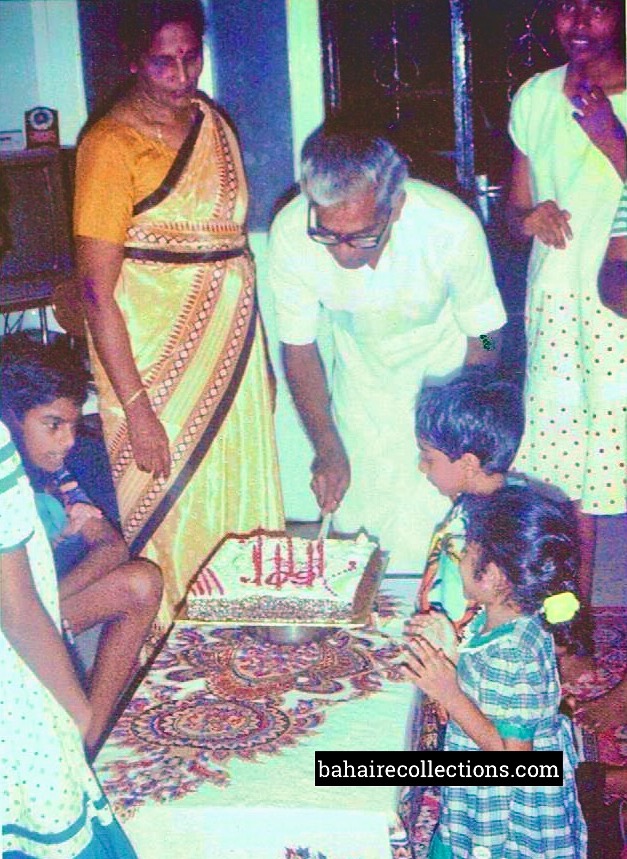
Celebrating his 60th birthday, 1990
A sudden heart attack came upon Karuppiah and he passed away at the age of sixty-two on 24 May 1992, having served on the Local Spiritual Assembly for a record period of thirty-one years. He was buried at the Malacca Bahá’í Memorial Park following a befitting Bahá’í funeral, attended by a large crowd of believers and non-believers. Thus ended the life of a simple man Karuppiah who was firm like an immovable mountain. He stood steadfast till the end of his life always upholding with all his might the good name of the Faith, which he loved and served with all sincerity. Till this day people who had associated with Karuppiah speak the same language, that Karuppiah had never harbored ill thoughts on anyone, and there were no reported incidents of he backbiting either. His wife Ponnayee who had been with him as his greatest supporter and strength in every moment and phase of his life ascended to the Abhá Kingdom on 10 December 2017 and was buried in the Malacca Bahá’í Memorial Park on 13 December 2017.
Karuppiah’s area of service was mainly confined to the town of Muar, but his services were noised across the country, and whenever outstation believers were traveling through Muar, they made it a point to call upon him. Karuppiah was a God-fearing believer who placed complete trust in God, and one whose face was always radiant and spoke with a magnetic smile that attracted everyone. Karuppiah’s is a story of an ordinary and simple man having overflowing love for the Faith, developing a high sense of loyalty and firmness in the Cause, single-handedly withstanding mighty opposition, undertaking individual initiatives as a lonely worker in the early days, and above all, winning the hearts and minds of the very community that opposed him. The example he had set shall forever decorate the pages of history.
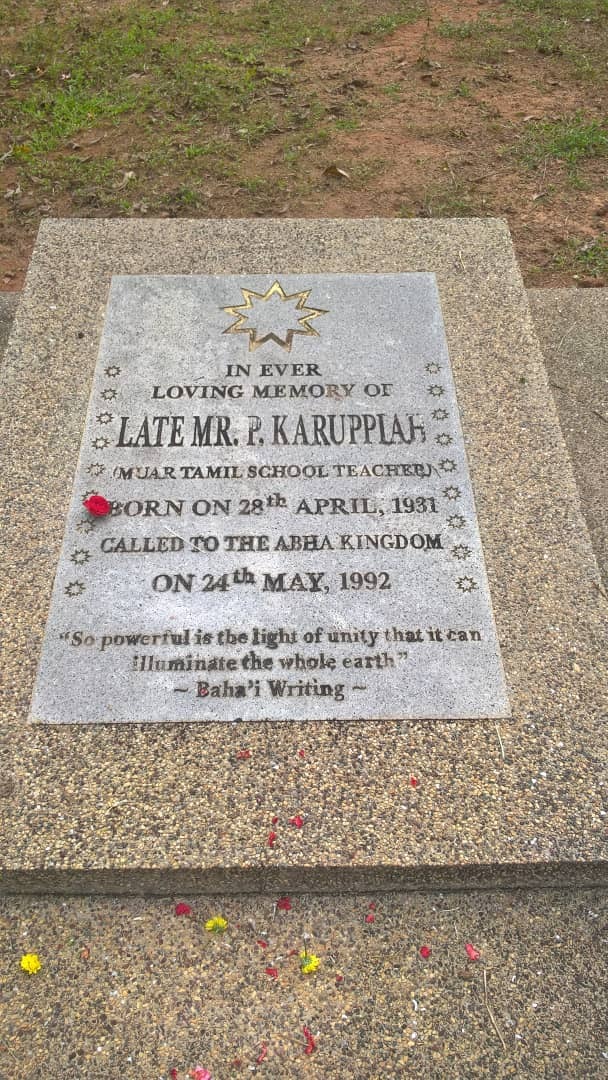
Resting place of Karuppiah, Bahá’í Memorial Garden, Malacca
A. Manisegaran
29 February 2020
Copyright©bahairecollections.com
21 thoughts on “REMEMBERING KARUPPIAH”
This is yet one more interesting episode in history in the call for the Cause of God. Individuals who arise and defy the odds and their achievements are exemplary. We hope that many others would be inspired by these stories and spur themselves for the Cause of God.
Merican
Singapore
What an inspiring story that comes on the eve of the first day of the fast. Thank you for another inspiring story of early history of the Faith in Malaysia. I really enjoy all your articles on early Malaysian Bahai history. For me these stories bring so much information and inspiration and they are so valuable because I became a Bahá’í in the 80s. So all these stories of the early believers are truly inspiring.
I wish I knew Karuppiah in person. His wife had played an important role in giving him all the strength for him to serve the Cause and promote a full Bahai family. Now that I have known about him and his wife through this story, I have every reason to visit their resting places in Malacca in my future visits to Malaysia and pay homage to these great servants of Bahá’u’lláh.
It is good to know the details of the establishment of early Bahá’í communities and we should always remember these early hero’s of the Faith. The sacrificial services and staunch fidelity of Mr. Karuppiah are exemplary.
Thank you dear Manisegaran for bringing out such a valuable history of the Faith in Malaysia.
Nehru Arunasalam
Chicago
USA
Gratitude.
Dear Mani,
Thank you for this moving story on the late Mr. Karuppiah. My daughter Mellissa and I stayed with the Karrappiahs- this beautiful, wonderful, loving and kind family for one week. But sadly we never got to meet Mr. Karuppiah as he had already ascended to the Abha Kigdom by then.
We were part of the family and were treated no otherwise. Mrs. Karruppiah would get up very early every morning to start cooking her beautiful dishes for the family and friends. She was very proud of her wonderful garden with the various amazing herbs, vegetables and beautiful flowers. I would sit sometimes with her in the kitchen just chatting about everything. She was so serene, loveable, radiant, kind and so are her children. We prayed, went on little teaching trips together. They took us to devotionals to meet other friends of theirs. Melissa and I also visited a daughter of theirs living in Singapore and were welcomed with warmness. We have wonderful memories and they are forever in our hearts. We are still in contact and waiting for them to visit us one day. Mrs. Karruppiah is watching over us from the Abha Kingdom.
Shaheedah Dollie
Geneva
Switzerland
Dear Shaheedah,
Thank you for your comments. I remember you made this trip to Malaysia in 2008 when Nirmala and I were still in Switzerland. You came back so impressed by so many friends you met in Malaysian and boasted of the unique and warm hospitaility that you said you had never witnessed in any other country that you had visited. I remember you mentioning that you made two visits to the home of Mr. Karuppiah as you became so attached to them. And the other persons of whom you sang praises were Jothee Ramasamy, her mother Madam Kanthamani and her husband Taraz Somu. Admittedly the Malaysian Bahai community, as you have seen for yourself, is very unique in many ways, with a genuine warm hospitaility topping it all.
Manisegaran
USA
A great, humble servant of Baha’u’llah who was enamoured by His love. I had the opportunity to spend more than a week in Muar in 1967, during which time I had the bounty of being embraced by his warmth and enthusiasm in teaching the Cause.
Kanthakumar
Jitra
Malaysia
Dear Mani,
Thank you for your story on Mr Karuppiah. Your write up on Karuppiah was most interesting, inspiring, and informative. Once I started reading, I couldn’t stop as it was so interesting and moving.
I have met him a number of times when I went to Muar in the early 1960s. My father, the late Mr. Leong Tat Chee knew Karuppiah very well. They worked closely together, teaching the Faith in the estates and going everywhere together. My father did mention his name often.
I must thank you profusely for refreshing our memories of a great Tamil teacher. In those days there were so few Tamil speaking teachers and Karuppiah was one of them and from my association with him and the details you have penned of him, I really admire this great and dedicated Bahai as a gem. He comes from humble beginnings and has understood the Faith so well for him to sacrifice earthly positions for the greater heavey rewards. We should have more Bahais like Karuppiah now as we no more have Baha’is like him anymore. The world needs such souls now and forever. This is the kind of stories you should write, which you are religiously doing.
Mani, you are really a good and gifted writer. You bring back history of the early days of the Faith, at a time when not many of are able to recollect the past with such keen accuracy and details. I don’t know how you manage to have so much minute details of the early believers and the early incidents. I feel you can easily write biographies of the early believers with so much information you have at your fingertips. And of course the huge collection of photos of the early days. They add value to your stories. I am very sure you have the Blessed Beauty blessing you in your sincere efforts undertaken for the preservation of the history in this country.
Lily Chinniah
Kuala Lumpur
Malaysia
Mani Jan,
I do not remember if I have met Karuppiah but reading about his life story I see that Karuppiah is the reminder of another radiant soul, a humble lover and devoted servant of the Cause of God that made a lasting impression with his devoted contributions to the growth of the Faith at the early and critical period of the development of the Faith in Malaysia. His exemplary life of service, of humility with low profile not only is commendable but in my understanding is a sample of invaluabe lesson for everyone of us to learn from, to participate and make our small bits of contribution to the path of service in the fast passing and ireplaceable moments of our life. God bless and reward his pure and radiant soul.
Dr. Firaydun Mithaq
Chieng Mai
Thailand
Dear Manisegaran,
You have written about a great soul who deserves to be well remembered in our history. I came to Muar in 1971 and secured a job as Purchasing Officer in ST Semiconductor. Since then I came to know Mr. Karuppiah and worked closely with him. Although he previously had some strong political connections he kept away and turned to the service for the Baha’i Faith with full concentration. He used to be known as the Teacher in White as he always appeared in white shirt and trousers.
I had an opportunity to serve with him on the Local Spiritual Assembly of Muar. He used to travel on motor cycle to teach the Faith, and had spoken to many of the Indian residents in Muar. It was my pleasure to have met him and we were almost inseparable in those days. After my work invariabilly I make it a point visit him in his house. Then we made plans to visit and go for the teaching activities. I used to take him on my motor cycle to visit my contacts, especially to Tangkak estate to conduct regular deepening classes. We spent many hours with them explaining about the Faith and praying with them. His understanding of the Faith was deep. They all respected Mr. Karuppiah greatly as an elderly person and also as a Tamil School teacher.
He was a good cook. When Nineteen Day Feasts were held in his house the friends found him a very good host. He cooked plenty of food, and his famous mutton curry was a must item. They all enjoyed his hospitality .
He took every effort to ensure all his 18 children became Baha’is and followed the Baha’i teachings. He took great interest in me. He persuaded me to get married. When I was ready, he introduced me to his sister Kirija who was then residing in a JKR quarters in Jalan Daud. We were married according to Baha’i rites on 1 February, 1992. We had a reception in Sin Kee Ting restaurant in Jalan Khalidi, Muar.
Mr. Karuppiah always placed Baha’i teaching work as priority in his daily life. He sacrificed everything for the Faith. His work for the Cause shall always remain in our memory. The essence of his services are well captured and preserved in this blog. Thank you.
Krishnan
Muar
Malaysia
Dear Manisegaran
The story you have written on Mr. Karuppiah is so touching and simply beautiful. I am amazed how a simple person with a large family of 18 children could serve the Faith constantly and effectively all his life. HIs steadfast service to the Cause with utmost sincerity and sacrifice is most appreciated. I read the story to my husband Mariappan, who accepted the Faith in the same year as Karuppiah. He remembers him vagule since he was far away in Muar. But he remembers the other Karuppiah from Kuala Pilah who passed away in 2016 in Seremban who was another spiritual giant.
Mani, do keep up the good work and furnish with more interesting stories of so many unsung heroes. You are writing about the true heroes who were almost forgotten. If not for your blog they would be forgotten forever.
Thank you
Jenny Wong
Seremban
Mr. Manisegaran,
Thank you so much writing about Mr. Karuppiah. It is through your story that I came to know about him. The Malaysian Bahai community and the Faith are blessed to be gifted with such believers. He has truly set an example for future generations to emulate. Humble beginnings is no hindrance to serve the Cause with distinction- this is a good message he has left behind. What is needed is nothing but sincerity of motive and purity of soul, which Mr. Karuppiah naturally had. We seldom find believers of such calibre. He belongs to the cream of believers of the Ten- Year Crusade period. He has added value to the community. The community, along with his family members can be proud of him.
Gurubalan Kuppusamy
Ipoh
Malaysia
Mr. Manisegaran
Thank you for writing about this believer of very stright forward and upright character. Your simple naration filled with so much spirit and life simply uplifts the feelings within the readers. Was a very good reading during these fasting days. Thank you very much for writing about this early believer who has shown the way in many ways for the future generations.
Santhira Karappan
Seremban
Malaysia
Until I read this story, I never knew of the existence of such a gem of a believer within our country. Thanks to this Bahai Historical blog; otherwise he would have been one of those whom time must had totally forgotten. But he shall surely be remembered by his Creator, for all his selfless services rendered without seeking attention, name, fame and recognition. His services have been fully and wholeheartedly for the love he had for Bahaullah.
Mr. Karuppiah has really been a dynamic teacher of our Faith in the early days. Malaysia in general, and Muar town in particular are certainly gifted to have possessed such a devoted, sincere and dedicated Baha’i teacher. His patience and tolerance to all the difficulties caused by those who opposed his belief must have been a great challenge. He never bartered the Faith for any posts or ranks of the outside world that were offered to him. This man’s life is certainly and undoubtedly a great inspiration to all of us.
It is equally interesting to learn how his wife accepted the Faith by his examplery life and stood through and through with him until his last breath, with she herself laying her life as a firm believer. We can all learn from this couple how to live a Bahai life and build a Bahai family.
Thank you once again Mr. Manisegaran for bringing us this story of this pure and loyal servant of Bahaullah. We need more stories of such great Bahai teachers who had led the way and shown the way in the early days for the current generation and generations yet to be born to emulate.
Arumugam Thanapah
Klang
Malaysia
Thank you Mani for yet another beautiful story . Truely well written and touched my heart .
Nemat Sabapathy
Australia
Dear Manisegaran,
I am truly thankful to you for your recollections of the late Mr. Karuppiah, otherwise known to many of us as “Muar Karuppiah”. I would have never had an opportunity to hear about the life or history or his dedicated services to the Faith if not for this beautiful chronological recollections.
For some years while I was serving in the Regional Bahai Council, I had the occassional opportunity to visit some of the Clusters in the Southen region, mainly Tangkak, Muar and Segamat. The name of Mr. Karuppiah used to revebrate among the friends during these visits, but often not a lengthy discussion but some some account about this great personality.
The life of Mr. Karuppiah, coming from a staunch Hindu and Tamil educationalist background reminds of many veterans in the Faith, some who have ascended to the Abha kingdom and some who are still around. These believers by virtue of the background were often held in high regards by the Indian community as bastions of the Hindu culture, education and language. Therefore accepting the Faith and to let go of established value system then would have been a challenging times for Mr. Karuppiah and the likes of him, let alone been wrongly accused of betrayal!
As I read through the recollections, it was evidently clear of the challenges that Mr. Karuppiah had to go through from time to time. However, his staunch belief, support and continued service in the institutions for almost 30 years is remarkable. In hindsight too, the visitors who streamed his home throughout his life became his companions and inspiration to him. A crop of young people moving into the community in the 1980’s was beginning to change the landscape of the community with Mr. Karuppiah as a respectable veteran to turn to for guidance and advice.
I am delighted to have read the recollections of Mr. Karuppiah, who has left a legacy of been a staunch supporter of the Faith, a virtuous person, an inspiration to many and whose name is always synonymous with the Muar community.
Sandran Govindasamy
Subang Jaya
Dear Manisegaran,
Thank you so much for writing on one who deserves to be engraved in the history of the Faith. This and such are the true, genuine and real stalwarts of Faith. who never sought name, fame, publicity and stage. He was resigned to service to the Kingdom, with no expecation of rewards. Yet he is rewarded by being remembered forever in history. I first heard from Bhaskaran Sangaran Nair and Raymond Peter of the greatness and great services of this Karuppiah, who with such a small salary and a large family was serving the Faith with distinction, and that he was able to provide warm hospitality to the string of visitors coming to his house.
It was later that I visited him in Muar and befriended him. I have the greatest admiration and respect for Karuppiah who discarded all earthly positions and chose the path of eternal salvation. I am certain God is already richly rewarding him for all his sacrifices rendered for the Cause and for establishing a good foundation in Muar when the need was there during the early days.
His strength was his wife, who together with him set up a Bahai home bringing all his children in the Bahai way. He had shown many of us the way to soldier on whatever the storm may be. His steadfastness in the Faith, firmness in the Covenant and obedience to the institutions are to be emulated by all.
Til this day I visit his grave in my hometown from time to time to pray for his soul and to reflect on the services of this believer gifted to us by Bahaullah.
Anthony C. Louis
Malacca
Malaysia.
I knew Mr. Karuppiah as the “Man in White.” He was a very loving and wise man, strong as a mountain in his faith.
In my early days, before pioneering to Papua New Guinea, he was an inspiration as he encouraged me to pioneer. I visited him and his family several time for Holy days, for fasting periods and during teaching campaigns. I loved the family environment, where all his children were active and involved in the service to the Caus. His faily gave me the idea of how we all could have an active Bahai Family.
When I visited Malaysia in 1985, I made a trip to Muar to see him and his family. He wanted his children to pioneer, and subsequently his son Manisegaran (namesake of the owner of this blog) pioneered to Papua New Guinea.
I could never forget Mr. Karuppiah who was very inspiring and exemplary to all who come to know him.
Ramu Sannyasi
New Zealand
Dear Uncle Mani,
This recollection of Mr. Karuppiah ‘The Man in White’ of Muar origin is truly inspirational. His great devotion and fortitude to serve his beloved Faith despite the inescapable opposition and crisis he faced. As the beloved Master said, “When there is love, nothing is too much trouble and there is always time.” I am so convinced that he was a man of love and unity. He has clearly exemplified that by putting his heart and soul for the ‘greater and true unity of the entire mankind rather than unity of his own kind.’ I feel so proud of his steadfastness, his sacrificial acts and unshakable faith he had in Bahá’u’lláh. A quiet man who had loudly proclaimed his love for mankind through his sincere actions. I pray that his service of love continues, and may the Blessed Beauty further strengthens this wonderful soul in the eternal realm.
With Loving Bahá’í Greetings,
Vela Gopal
Phnom Penh, Cambodia
This is a very interesting and inspiring life history of Mr. P. Karuppiah. He was such a humble teacher, who accepted the faith of Baha’ullah, and served his Faith with such a burning love. His wife who also accepted the Faith through him was his strength. Together they built a Bahai home. He was simple school teacher who taught the Faith with such an obession.
From what I have read he seems to be a man of principle, honesty and trustworthiness. I really salute him for what he was in the early days of the Faith. We are always inspired by the Bahai writings and the examples set by the early believers. Here is Karuppiah who has a special place in the history and in my heart. May Baha’ullah bless his soul.
Thank you dear Manisegaran for writing this story which has truly inspired me.
Chosin Abdullah
Jakarta
Indonesia.
Beautiful and so inspiring a story. The commitment he had for serving the community, the clarity with which he carried out his life and the sacrifices he made are simply remarkable.
Paramesvary Velayutham
Subang Jaya
Malaysia
Dear Manisegaran
What a story that evoked so much emotions within me. You took me back to the very year I accepted the Faith. It was in early August 1960 that I accepted the Faith. In the same month I undertook a trip to Muar with the late T.K. Kannan and we rented a room in Muar for one week. We rented bicycles to go around the town to teach the people. In that trip we met Mr. William Koren as the key contact person, and in the following year we noted that he and his sister Inyce and Mr. Karuppiah had accepted the Faith and were firebrands.
I left for pioneering to India in May 1967 and each time I came back to Malaysia, I kept hearing believer placing accolades on Karuppiah. I was delighted to learn that he had brought his wide and children into the Faith. That was something to reflect upon. Being a simple and humble Tamil school teacher, it amazes me to learn the depth of his understanding of the Faith which led him to be so firm in the Faith till his last days. He has indeed led an exemplary way of life for many in the current and future generations to emulate.
I am happy that this stalwart who was an unsung hero but one who deserves to be remembered forever has been well mentioned in this Bahai blog.
Dr. S. Vasudevan
Pune
India
Every one must show forth deeds that are pure and holy, for words are the property of all alike, whereas such deeds as these belong only to Our loved ones (Bahá’u’lláh)
The above verse came to my mind spontaneously as I read the story of Karuppiah.
There are, especially in the early days of our Faith in Malaysia [Malaya then], men in particular, after accepting Bahá’u’lláh did not shirk in their beliefs ; they are among those, whom ‘Abdu’l-Bahá found, even from the Realms above, “searching through the lands and seas to find souls who can become heralds of the Cause”.
Karuppiah was one of these believers. His deeds, found another supporter for the Faith, none other than his wife. She witnessed a different person in him after Karuppiah accepted the Faith.
After accepting the Bahá’í Faith, men like Karruppiah, through their exemplary deeds, attracted their spouses, who without hesitation, not only accepted the Faith but became ardent supporters.
I myself encountered, one such believer – Mr. Sunday, from Calabar, Nigeria who stopped drinking immediately he accepted the Faith, as recounted by his wife to me, during my visit to Fernando Po in 1973. She accepted the Faith without much understanding what the Faith meant to her but simply witnessing the sudden change in her husband.
Certainly, Karuppiah, the man in white’ did not stop with the victories he may have witnessed but plodded on …. In the path of service.
Like many of the early believers in Malaysia, Karrupiah gave great service time for the propagation of the Faith he believed in.
May his soul ‘plunge in the world of mysteries’.
Kamachee Martel
Lesotho
Africa